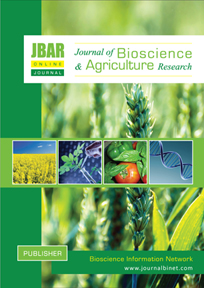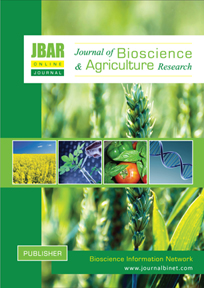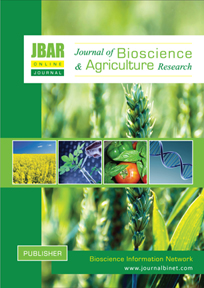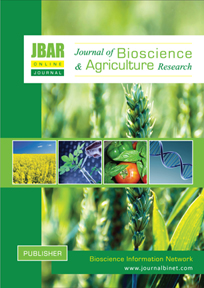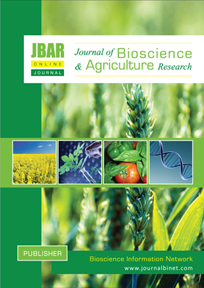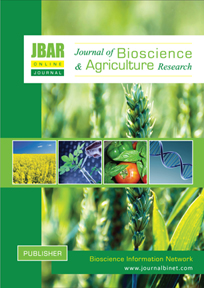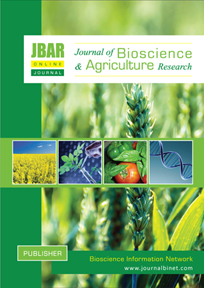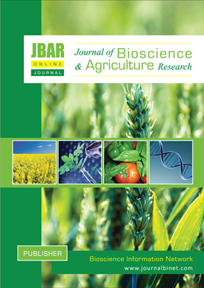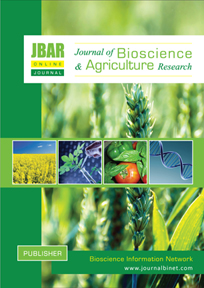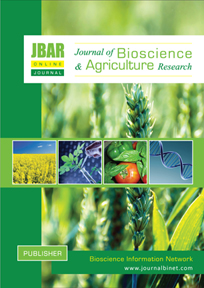Journal of Bioscience and Agriculture Research
Volume 29 - Issue 01 | Year of Publication: 2022
Article Type: Research Article | No. 291, 2022 | Country: Bangladesh | pp. 2399-2406 | Open Access
Title: Screening of oxytetracycline & chlortetracycline residues in poultry feeds in Bangladesh
Authors: Islam, P., Biswas, S. K., Hossain, M. I., Khatun, P., Sikder, M. H. and Islam, A.
DOI: https://doi.org/10.18801/jbar.290122.291
Title: Screening of oxytetracycline & chlortetracycline residues in poultry feeds in Bangladesh
Authors: Islam, P., Biswas, S. K., Hossain, M. I., Khatun, P., Sikder, M. H. and Islam, A.
DOI: https://doi.org/10.18801/jbar.290122.291
Screening of oxytetracycline & chlortetracycline residues in poultry feeds in Bangladesh
Abstract
A total of 112 poultry feed samples were screened for oxytetracycline and chlortetracycline antibiotic residues by thin-layer chromatography (TLC). The samples were collected from Natore, Naogaon, Rangpur and Comilla districts of Bangladesh. Poultry feed samples were classified according to their product type (homemade, commercial) and types of poultry feed (broiler feed, layer feed and sonali feed). All the homemade poultry feed samples (100%) tested positive for oxytetracycline and chlortetracycline antibiotic residue when screened. About 95% of commercial poultry feed tested positive for antibiotic residue in all four districts. In this study, the positive screening for oxytetracycline and chlortetracycline antibiotic residue in broiler, layer and sonali poultry feed types are 98%, 95% and 90%, respectively. This study also observed that antibiotic residue remained in feed samples irrespective of temperature and time as they had been stored for about a year at room temperature. From this study, it was revealed that the use of antibiotics in poultry feeds was extensive. Moreover, the duration of sustaining in poultry feed also raised concerns regarding their use and effect on the environment. This study has also increased the concern about the strict monitoring of the use of antibiotics in the poultry industry.
Key Words: Oxytetracycline, Chlortetracycline, Poultry feed and TLC.
Abstract
A total of 112 poultry feed samples were screened for oxytetracycline and chlortetracycline antibiotic residues by thin-layer chromatography (TLC). The samples were collected from Natore, Naogaon, Rangpur and Comilla districts of Bangladesh. Poultry feed samples were classified according to their product type (homemade, commercial) and types of poultry feed (broiler feed, layer feed and sonali feed). All the homemade poultry feed samples (100%) tested positive for oxytetracycline and chlortetracycline antibiotic residue when screened. About 95% of commercial poultry feed tested positive for antibiotic residue in all four districts. In this study, the positive screening for oxytetracycline and chlortetracycline antibiotic residue in broiler, layer and sonali poultry feed types are 98%, 95% and 90%, respectively. This study also observed that antibiotic residue remained in feed samples irrespective of temperature and time as they had been stored for about a year at room temperature. From this study, it was revealed that the use of antibiotics in poultry feeds was extensive. Moreover, the duration of sustaining in poultry feed also raised concerns regarding their use and effect on the environment. This study has also increased the concern about the strict monitoring of the use of antibiotics in the poultry industry.
Key Words: Oxytetracycline, Chlortetracycline, Poultry feed and TLC.
MHOW TO CITE THIS ARTICLE?
MLA
Islam, P. et al. “Screening of oxytetracycline & chlortetracycline residues in poultry feeds in Bangladesh”. Journal of Bioscience and Agriculture Research, 29(01), (2022): 2399-2406.
APA
Islam, P., Biswas, S. K., Hossain, M. I., Khatun, P. Sikder, M. H. and Islam, A. (2022). Screening of oxytetracycline & chlortetracycline residues in poultry feeds in Bangladesh. Journal of Bioscience and Agriculture Research, 29 (01), 2399-2406.
Chicago
Islam, P., Biswas, S. K., Hossain, M. I., Khatun, P., Sikder, M. H. and Islam, A. “Screening of oxytetracycline & chlortetracycline residues in poultry feeds in Bangladesh”. Journal of Bioscience and Agriculture Research, 29(01), (2022): 2399-2406.
Harvard
Islam, P., Biswas, S. K., Hossain, M. I., Khatun, P., Sikder, M. H. and Islam, A. 2022. Screening of oxytetracycline & chlortetracycline residues in poultry feeds in Bangladesh. Journal of Bioscience and Agriculture Research, 29(01), pp. 2399-2406.
Vancouver
Islam, P, Biswas, SK, Sikder, MH, Hossain, MI, Khatun, P and Islam, A. Screening of oxytetracycline & chlortetracycline residues in poultry feeds in Bangladesh. Journal of Bioscience and Agriculture Research, 2022 May 29(01): 2399-2406.
MLA
Islam, P. et al. “Screening of oxytetracycline & chlortetracycline residues in poultry feeds in Bangladesh”. Journal of Bioscience and Agriculture Research, 29(01), (2022): 2399-2406.
APA
Islam, P., Biswas, S. K., Hossain, M. I., Khatun, P. Sikder, M. H. and Islam, A. (2022). Screening of oxytetracycline & chlortetracycline residues in poultry feeds in Bangladesh. Journal of Bioscience and Agriculture Research, 29 (01), 2399-2406.
Chicago
Islam, P., Biswas, S. K., Hossain, M. I., Khatun, P., Sikder, M. H. and Islam, A. “Screening of oxytetracycline & chlortetracycline residues in poultry feeds in Bangladesh”. Journal of Bioscience and Agriculture Research, 29(01), (2022): 2399-2406.
Harvard
Islam, P., Biswas, S. K., Hossain, M. I., Khatun, P., Sikder, M. H. and Islam, A. 2022. Screening of oxytetracycline & chlortetracycline residues in poultry feeds in Bangladesh. Journal of Bioscience and Agriculture Research, 29(01), pp. 2399-2406.
Vancouver
Islam, P, Biswas, SK, Sikder, MH, Hossain, MI, Khatun, P and Islam, A. Screening of oxytetracycline & chlortetracycline residues in poultry feeds in Bangladesh. Journal of Bioscience and Agriculture Research, 2022 May 29(01): 2399-2406.
Article Type: Research Article | No. 292, 2022 | Country: Bangladesh | pp. 2407-2415 | Open Access
Title: Influence of humic acid on morpho-physiology and yield of rice
Authors: Barai, S., Islam, M. M., Parvin, S., Nizam, R. and Bithy, P. A.
DOI: https://doi.org/10.18801/jbar.290122.292
Title: Influence of humic acid on morpho-physiology and yield of rice
Authors: Barai, S., Islam, M. M., Parvin, S., Nizam, R. and Bithy, P. A.
DOI: https://doi.org/10.18801/jbar.290122.292
Influence of humic acid on morpho-physiology and yield of rice
Abstract
A pot experiment was conducted to investigate the influence of soil organic amendments-cow dung and humic acid on morphology and yield of rice under drought stress at the net-house, Agricultural Botany Department at Sher-e-Bangla Agricultural University, during the period from July 2018 to November 2018. This single factorial experiment pots where arranged in a randomized complete block design with four replications. Four different levels of soil organic amendments viz. SM1 = Soil + inorganic fertilizer (control), SM2 = Soil + cow dung + inorganic fertilizer, SM3 = Soil + inorganic fertilizer + humic acid and SM4 = Soil + inorganic fertilizer + cow dung + humic acid. The results showed that morphological characters and yield of rice significantly increased with addition of cow dung and humic acid into the soil. In terms of morpho-physiology, the highest plant height 112.90 cm and number of tillers plant-1 11.25 were achieved from the treatment SM4 (Soil + inorganic fertilizer + cow dung + humic acid). In terms of the variables that contribute to the yield, the highest days to 1st flowering (72.75) and days to 1st maturity (122.05 days) were found from control treatment SM4 (Soil + inorganic fertilizer + humic acid + cow dung). Similarly, the highest panicle length (24.94 cm), number of filled grain panicle-1 (221.40), number of unfilled grain panicle-1 (42.25), root length (17.93 cm), number of grains panicle-1 (247.40), grain weight hill-1 (25.17 g), straw weight hill-1 (33.26 g) and harvest index (42.93%) were achieved from SM4 (Soil + inorganic fertilizer + cow dung + humic acid) . The highest soil moisture content (17.23 and 16.17% at 55 and 70 DAT, respectively) was also achieved from SM4 (Soil + inorganic fertilizer + cow dung + humic acid). This experimental results highlighted that together use of cow dung and humic acid increased the grain weight plants-1 more than 150% compared to controlled condition. Finally, it concluded that application of cow dung and humic acid as soil organic amendments increases the yield of aman rice.
Key Words: Growth performance, Cow dung, Soil moisture, Root length and Production
Abstract
A pot experiment was conducted to investigate the influence of soil organic amendments-cow dung and humic acid on morphology and yield of rice under drought stress at the net-house, Agricultural Botany Department at Sher-e-Bangla Agricultural University, during the period from July 2018 to November 2018. This single factorial experiment pots where arranged in a randomized complete block design with four replications. Four different levels of soil organic amendments viz. SM1 = Soil + inorganic fertilizer (control), SM2 = Soil + cow dung + inorganic fertilizer, SM3 = Soil + inorganic fertilizer + humic acid and SM4 = Soil + inorganic fertilizer + cow dung + humic acid. The results showed that morphological characters and yield of rice significantly increased with addition of cow dung and humic acid into the soil. In terms of morpho-physiology, the highest plant height 112.90 cm and number of tillers plant-1 11.25 were achieved from the treatment SM4 (Soil + inorganic fertilizer + cow dung + humic acid). In terms of the variables that contribute to the yield, the highest days to 1st flowering (72.75) and days to 1st maturity (122.05 days) were found from control treatment SM4 (Soil + inorganic fertilizer + humic acid + cow dung). Similarly, the highest panicle length (24.94 cm), number of filled grain panicle-1 (221.40), number of unfilled grain panicle-1 (42.25), root length (17.93 cm), number of grains panicle-1 (247.40), grain weight hill-1 (25.17 g), straw weight hill-1 (33.26 g) and harvest index (42.93%) were achieved from SM4 (Soil + inorganic fertilizer + cow dung + humic acid) . The highest soil moisture content (17.23 and 16.17% at 55 and 70 DAT, respectively) was also achieved from SM4 (Soil + inorganic fertilizer + cow dung + humic acid). This experimental results highlighted that together use of cow dung and humic acid increased the grain weight plants-1 more than 150% compared to controlled condition. Finally, it concluded that application of cow dung and humic acid as soil organic amendments increases the yield of aman rice.
Key Words: Growth performance, Cow dung, Soil moisture, Root length and Production
MHOW TO CITE THIS ARTICLE?
MLA
Barai, S. et al. “Influence of humic acid on morpho-physiology and yield of rice”. Journal of Bioscience and Agriculture Research, 29(01), (2022): 2407-2415.
APA
Barai, S., Islam, M. M., Parvin, S., Nizam, R. and Bithy, P. A. (2022). Influence of humic acid on morpho-physiology and yield of rice. Journal of Bioscience and Agriculture Research, 29 (01), 2407-2415.
Chicago
Barai, S., Islam, M. M., Parvin, S., Nizam, R. and Bithy, P. A. “Influence of humic acid on morpho-physiology and yield of rice”. Journal of Bioscience and Agriculture Research, 29(01), (2022): 2407-2415.
Harvard
Barai, S., Islam, M. M., Parvin, S., Nizam, R. and Bithy, P. A. 2022. Influence of humic acid on morpho-physiology and yield of rice. Journal of Bioscience and Agriculture Research, 29(01), pp. 2407-2415.
Vancouver
Barai, S, Islam, MM, Parvin, S, Nizam, R and Bithy, PA. Influence of humic acid on morpho-physiology and yield of rice. Journal of Bioscience and Agriculture Research, 2022 May 29(01): 2407-2415.
MLA
Barai, S. et al. “Influence of humic acid on morpho-physiology and yield of rice”. Journal of Bioscience and Agriculture Research, 29(01), (2022): 2407-2415.
APA
Barai, S., Islam, M. M., Parvin, S., Nizam, R. and Bithy, P. A. (2022). Influence of humic acid on morpho-physiology and yield of rice. Journal of Bioscience and Agriculture Research, 29 (01), 2407-2415.
Chicago
Barai, S., Islam, M. M., Parvin, S., Nizam, R. and Bithy, P. A. “Influence of humic acid on morpho-physiology and yield of rice”. Journal of Bioscience and Agriculture Research, 29(01), (2022): 2407-2415.
Harvard
Barai, S., Islam, M. M., Parvin, S., Nizam, R. and Bithy, P. A. 2022. Influence of humic acid on morpho-physiology and yield of rice. Journal of Bioscience and Agriculture Research, 29(01), pp. 2407-2415.
Vancouver
Barai, S, Islam, MM, Parvin, S, Nizam, R and Bithy, PA. Influence of humic acid on morpho-physiology and yield of rice. Journal of Bioscience and Agriculture Research, 2022 May 29(01): 2407-2415.
Article Type: Research Article | No. 293, 2022 | Country: Bangladesh | pp. 2416-2425 | Open Access
Title: Salinity: A chain to be assessed
Authors: Islam, P., Khatun, P. and Islam, A.
DOI: https://doi.org/10.18801/jbar.290122.293
Title: Salinity: A chain to be assessed
Authors: Islam, P., Khatun, P. and Islam, A.
DOI: https://doi.org/10.18801/jbar.290122.293
Salinity: A chain to be assessed
Abstract
Salinity intrusion is a major problem, particularly in the coastal area of Bangladesh. This review aims to know the development, present scenario, causes, detection technique, impact and management of salinity intrusion in Bangladesh to assess the salinity chain. Salinity has numerous direct and indirect impacts like hypertension, eclampsia and diarrhoea in humans derived from drinking water, crops, livestock and fish from the affected areas. Salinity affects human life, livelihood, health and well-being and is also closely linked with ecosystems that hamper food production. By decreasing crop, livestock and fish yield, salinity intrusion continuously leads the nation to food insecurity. To overcome salinity intrusion, some management ways are also discussed here.
Key Words: Salinity, Causes, Detection technique, Impacts and Management
Abstract
Salinity intrusion is a major problem, particularly in the coastal area of Bangladesh. This review aims to know the development, present scenario, causes, detection technique, impact and management of salinity intrusion in Bangladesh to assess the salinity chain. Salinity has numerous direct and indirect impacts like hypertension, eclampsia and diarrhoea in humans derived from drinking water, crops, livestock and fish from the affected areas. Salinity affects human life, livelihood, health and well-being and is also closely linked with ecosystems that hamper food production. By decreasing crop, livestock and fish yield, salinity intrusion continuously leads the nation to food insecurity. To overcome salinity intrusion, some management ways are also discussed here.
Key Words: Salinity, Causes, Detection technique, Impacts and Management
MHOW TO CITE THIS ARTICLE?
MLA
Islam, P. et al. “Salinity: A chain to be assessed”. Journal of Bioscience and Agriculture Research, 29(01), (2022): 2416-2425.
APA
Islam, P., Khatun, P. and Islam, A. (2022). Salinity: A chain to be assessed. Journal of Bioscience and Agriculture Research, 29(01), 2416-2425.
Chicago
Islam, P., Khatun, P. and Islam, A. “Salinity: A chain to be assessed”. Journal of Bioscience and Agriculture Research, 29(01), (2022): 2416-2425.
Harvard
Islam, P., Khatun, P. and Islam, A. 2022. Salinity: A chain to be assessed. Journal of Bioscience and Agriculture Research, 29(01), pp. 2416-2425.
Vancouver
Islam, P, Khatun, P and Islam, A. Salinity: A chain to be assessed. Journal of Bioscience and Agriculture Research, 2022 July, 29(01): 2416-2425.
MLA
Islam, P. et al. “Salinity: A chain to be assessed”. Journal of Bioscience and Agriculture Research, 29(01), (2022): 2416-2425.
APA
Islam, P., Khatun, P. and Islam, A. (2022). Salinity: A chain to be assessed. Journal of Bioscience and Agriculture Research, 29(01), 2416-2425.
Chicago
Islam, P., Khatun, P. and Islam, A. “Salinity: A chain to be assessed”. Journal of Bioscience and Agriculture Research, 29(01), (2022): 2416-2425.
Harvard
Islam, P., Khatun, P. and Islam, A. 2022. Salinity: A chain to be assessed. Journal of Bioscience and Agriculture Research, 29(01), pp. 2416-2425.
Vancouver
Islam, P, Khatun, P and Islam, A. Salinity: A chain to be assessed. Journal of Bioscience and Agriculture Research, 2022 July, 29(01): 2416-2425.
Article Type: Research Article | No. 294, 2022 | Country: Bangladesh | pp. 2426-2432 | Open Access
Title: Effect of different fertilizer doses on the yield of sesame in Charland
Authors: Roy, S., Rahaman, M. A., Rahman, M. M., Hasan, G. N. and Sarkar, M. N.
DOI: https://doi.org/10.18801/jbar.290122.294
Title: Effect of different fertilizer doses on the yield of sesame in Charland
Authors: Roy, S., Rahaman, M. A., Rahman, M. M., Hasan, G. N. and Sarkar, M. N.
DOI: https://doi.org/10.18801/jbar.290122.294
Effect of different fertilizer doses on the yield of sesame in Charland
Abstract
To determine the optimal nutrient management packages for BARI Til-4 in Charland areas and increase production along with farmers’ income, an experiment was conducted under Charland at the multi-location testing site, Bhuapur of the On-Farm Research Division, Bangladesh Agricultural Research Institute, Tangail under AEZ-8 Tangail during two consecutive years of Kharif 2016 and 2017.Three different fertilizer doses were used, namely T1: 107-39-32-17-3.6-0.6 kg ha-1 (based on soil test), T2: 37-20-16-13-2-1 kg ha-1 + 5 t ha-1 cowdung (based on IPNS), and T3: 18-8-18-0-0-0 kg ha-1 NPKSZnB. (farmers practice). Between the two years, among the treatments, the soil test-based fertilizer dose provided the highest seed yield (1.39 t ha-1), which was comparable to the IPNS-based fertilizer dose (1.29 t ha-1), while the farmers' practiced fertilizer dose produced the lowest seed yield (0.78 t ha-1). T1 treatment resulted in a yield increase of 7.75 and 78.20 percent when compared to T2 and T3 treatments, respectively. The highest gross return (Tk. 65500 ha-1) and gross margin (Tk. 27637.64 ha-1) from T1 treatment, whereas the lowest return (Tk. 41500 ha-1) and gross margin (Tk. 2505.04 ha-1) were obtained from farmer practice. According to the overall results, a soil test-based fertilizer dose may be recommended in Charland sections of AEZ-8 for increased production and economic return.
Key Words: Charland, Sesame, BARI Til-4, Fertilizer dose and Yield.
Abstract
To determine the optimal nutrient management packages for BARI Til-4 in Charland areas and increase production along with farmers’ income, an experiment was conducted under Charland at the multi-location testing site, Bhuapur of the On-Farm Research Division, Bangladesh Agricultural Research Institute, Tangail under AEZ-8 Tangail during two consecutive years of Kharif 2016 and 2017.Three different fertilizer doses were used, namely T1: 107-39-32-17-3.6-0.6 kg ha-1 (based on soil test), T2: 37-20-16-13-2-1 kg ha-1 + 5 t ha-1 cowdung (based on IPNS), and T3: 18-8-18-0-0-0 kg ha-1 NPKSZnB. (farmers practice). Between the two years, among the treatments, the soil test-based fertilizer dose provided the highest seed yield (1.39 t ha-1), which was comparable to the IPNS-based fertilizer dose (1.29 t ha-1), while the farmers' practiced fertilizer dose produced the lowest seed yield (0.78 t ha-1). T1 treatment resulted in a yield increase of 7.75 and 78.20 percent when compared to T2 and T3 treatments, respectively. The highest gross return (Tk. 65500 ha-1) and gross margin (Tk. 27637.64 ha-1) from T1 treatment, whereas the lowest return (Tk. 41500 ha-1) and gross margin (Tk. 2505.04 ha-1) were obtained from farmer practice. According to the overall results, a soil test-based fertilizer dose may be recommended in Charland sections of AEZ-8 for increased production and economic return.
Key Words: Charland, Sesame, BARI Til-4, Fertilizer dose and Yield.
MHOW TO CITE THIS ARTICLE?
MLA
Roy, S. et al. “Effect of different fertilizer doses on the yield of sesame in Charland”. Journal of Bioscience and Agriculture Research, 29(01), (2022): 2426-2432.
APA
Roy, S., Rahaman, M. A., Rahman, M. M., Hasan, G. N. and Sarkar, M. N. (2022). Effect of different fertilizer doses on the yield of sesame in Charland. Journal of Bioscience and Agriculture Research, 29(01), 2426-2432.
Chicago
Roy, S., Rahaman, M. A., Rahman, M. M., Hasan, G. N. and Sarkar, M. N. “Effect of different fertilizer doses on the yield of sesame in Charland”. Journal of Bioscience and Agriculture Research, 29(01), (2022): 2426-2432.
Harvard
Roy, S., Rahaman, M. A., Rahman, M. M., Hasan, G. N. and Sarkar, M. N. 2022. Effect of different fertilizer doses on the yield of sesame in Charland. Journal of Bioscience and Agriculture Research, 29(01), pp. 2426-2432.
Vancouver
Roy, S, Rahaman, MA, Rahman, MM, Hasan, GN and Sarkar, MN. Effect of different fertilizer doses on the yield of sesame in Charland. Journal of Bioscience and Agriculture Research, 2022 July, 29(01): 2426-2432.
MLA
Roy, S. et al. “Effect of different fertilizer doses on the yield of sesame in Charland”. Journal of Bioscience and Agriculture Research, 29(01), (2022): 2426-2432.
APA
Roy, S., Rahaman, M. A., Rahman, M. M., Hasan, G. N. and Sarkar, M. N. (2022). Effect of different fertilizer doses on the yield of sesame in Charland. Journal of Bioscience and Agriculture Research, 29(01), 2426-2432.
Chicago
Roy, S., Rahaman, M. A., Rahman, M. M., Hasan, G. N. and Sarkar, M. N. “Effect of different fertilizer doses on the yield of sesame in Charland”. Journal of Bioscience and Agriculture Research, 29(01), (2022): 2426-2432.
Harvard
Roy, S., Rahaman, M. A., Rahman, M. M., Hasan, G. N. and Sarkar, M. N. 2022. Effect of different fertilizer doses on the yield of sesame in Charland. Journal of Bioscience and Agriculture Research, 29(01), pp. 2426-2432.
Vancouver
Roy, S, Rahaman, MA, Rahman, MM, Hasan, GN and Sarkar, MN. Effect of different fertilizer doses on the yield of sesame in Charland. Journal of Bioscience and Agriculture Research, 2022 July, 29(01): 2426-2432.
Article Type: Research Article | No. 295, 2022 | Country: Bangladesh | pp. 2433-2441 | Open Access
Title: Growth performance of Spirulina platensis in supernatant of digested rotten guava
Authors: Islam, M. S., Habib, M. A. B., Rahman, M. H. and Arifuzzaman, M.
DOI: https://doi.org/10.18801/jbar.290122.295
Title: Growth performance of Spirulina platensis in supernatant of digested rotten guava
Authors: Islam, M. S., Habib, M. A. B., Rahman, M. H. and Arifuzzaman, M.
DOI: https://doi.org/10.18801/jbar.290122.295
Growth performance of Spirulina platensis in supernatant of digested rotten guava
Abstract
This study was performed to evaluate the culture potentiality and growth performance of Spirulina (Spirulina platensis) in supernatant of three different concentrations of digested rotten guava (DRG) and Kosaric Medium (KM) as control. The study consisted of three different concentrations of rotten guavas, such as 20 (T1), 40 (T2) and 60 (T3) were allowed to digest under aeration. After 34 days, three replications showed the reddish white-colored supernatant screened and taken in a 2.0 L conical flask. Then, Spirulina was inoculated to grow in these three digested rotten guava media (DRGM) with the addition of micronutrients and KM and 9.0 g/L NaHCO3 for 14 days. The cell weight of Spirulina was attained at a maximum of 12.43±0.10 mg/L (dry wt. basis) in KM, followed by 0.818 ± 0.002, 0.815 ± 0.0014 and 0.809± 0.0011 mg/L in supernatant of 60, 20 and 40% DRGM, respectively on the 10th day of culture. A similar trend was also observed in the case of specific growth rates (based on cell weight and chlorophyll a) and total biomass (mg/L) of Spirulina. Cell weight of Spirulina had a highly significant (P<0.01) correlation with the chlorophyll a content (r= 0.746) and total biomass (r= 0.742) of Spirulina. The results on the growth performance showed that Spirulina grown in supernatant of 60% DRGM was significantly (P<0.01) higher (T3) than that of Spirulina grown in supernatant of 20% (T1) and 40% DRGM (T2).
Key Words: Culture potentiality, Growth performance, Spirulina platensis, Digested Rotten Guava Media (DRGM)
Abstract
This study was performed to evaluate the culture potentiality and growth performance of Spirulina (Spirulina platensis) in supernatant of three different concentrations of digested rotten guava (DRG) and Kosaric Medium (KM) as control. The study consisted of three different concentrations of rotten guavas, such as 20 (T1), 40 (T2) and 60 (T3) were allowed to digest under aeration. After 34 days, three replications showed the reddish white-colored supernatant screened and taken in a 2.0 L conical flask. Then, Spirulina was inoculated to grow in these three digested rotten guava media (DRGM) with the addition of micronutrients and KM and 9.0 g/L NaHCO3 for 14 days. The cell weight of Spirulina was attained at a maximum of 12.43±0.10 mg/L (dry wt. basis) in KM, followed by 0.818 ± 0.002, 0.815 ± 0.0014 and 0.809± 0.0011 mg/L in supernatant of 60, 20 and 40% DRGM, respectively on the 10th day of culture. A similar trend was also observed in the case of specific growth rates (based on cell weight and chlorophyll a) and total biomass (mg/L) of Spirulina. Cell weight of Spirulina had a highly significant (P<0.01) correlation with the chlorophyll a content (r= 0.746) and total biomass (r= 0.742) of Spirulina. The results on the growth performance showed that Spirulina grown in supernatant of 60% DRGM was significantly (P<0.01) higher (T3) than that of Spirulina grown in supernatant of 20% (T1) and 40% DRGM (T2).
Key Words: Culture potentiality, Growth performance, Spirulina platensis, Digested Rotten Guava Media (DRGM)
MHOW TO CITE THIS ARTICLE?
MLA
Islam, M. S. et al. “The growth performance of Spirulina Platensis in supernatant of digested rotten guava”. Journal of Bioscience and Agriculture Research, 29(01), (2022): 2433-2441.
APA
Islam, M. S., Habib, M. A. B., Rahman, M. H. and Arifuzzaman, M. (2022). The growth performance of Spirulina Platensis in supernatant of digested rotten guava. Journal of Bioscience and Agriculture Research, 29(01), 2433-2441.
Chicago
Islam, M. S., Habib, M. A. B., Rahman, M. H. and Arifuzzaman, M. “The growth performance of Spirulina Platensis in supernatant of digested rotten guava”. Journal of Bioscience and Agriculture Research, 29(01), (2022): 2433-2441.
Harvard
Islam, M. S., Habib, M. A. B., Rahman, M. H. and Arifuzzaman, M. 2022. The growth performance of Spirulina Platensis in supernatant of digested rotten guava. Journal of Bioscience and Agriculture Research, 29(01), pp. 2433-2441.
Vancouver
Islam, MS, Habib, MAB, Rahman, MH and Arifuzzaman, M. The growth performance of Spirulina Platensis in supernatant of digested rotten guava. Journal of Bioscience and Agriculture Research, 2022 August, 29(01): 2433-2441.
MLA
Islam, M. S. et al. “The growth performance of Spirulina Platensis in supernatant of digested rotten guava”. Journal of Bioscience and Agriculture Research, 29(01), (2022): 2433-2441.
APA
Islam, M. S., Habib, M. A. B., Rahman, M. H. and Arifuzzaman, M. (2022). The growth performance of Spirulina Platensis in supernatant of digested rotten guava. Journal of Bioscience and Agriculture Research, 29(01), 2433-2441.
Chicago
Islam, M. S., Habib, M. A. B., Rahman, M. H. and Arifuzzaman, M. “The growth performance of Spirulina Platensis in supernatant of digested rotten guava”. Journal of Bioscience and Agriculture Research, 29(01), (2022): 2433-2441.
Harvard
Islam, M. S., Habib, M. A. B., Rahman, M. H. and Arifuzzaman, M. 2022. The growth performance of Spirulina Platensis in supernatant of digested rotten guava. Journal of Bioscience and Agriculture Research, 29(01), pp. 2433-2441.
Vancouver
Islam, MS, Habib, MAB, Rahman, MH and Arifuzzaman, M. The growth performance of Spirulina Platensis in supernatant of digested rotten guava. Journal of Bioscience and Agriculture Research, 2022 August, 29(01): 2433-2441.
Volume 29 - Issue 02 | Year of Publication: 2022
Article Type: Research Article | No. 296, 2022 | Country: Bangladesh | pp. 2442-2449 | Open Access
Title: Growth and flowering responses of Lisianthus to different plant spacing
Authors: Husna, M. A., Sultana, M. N., Maliha, M., Dina, A. and Uddin, A. F. M. J.
DOI: https://doi.org/10.18801/jbar.290222.296
Title: Growth and flowering responses of Lisianthus to different plant spacing
Authors: Husna, M. A., Sultana, M. N., Maliha, M., Dina, A. and Uddin, A. F. M. J.
DOI: https://doi.org/10.18801/jbar.290222.296
Growth and flowering responses of Lisianthus to different plant spacing
Abstract
A field experiment was accomplished at the Horticulture farm of Sher-e-Bangla Agricultural University to study the effect of different plant spacing on the growth and flowering of Lisianthus (variety-SAU Blue Nandini). Plant Spacings viz. S1= 30 cm x 15 cm (BARI recommended for Gerbera), S2= 30 cm x 20 cm, S3= 30 cm x 25 cm were used in this experiment arranged in a Randomized Complete Block Design with three replications. Data on different growth and flower yield attribute parameters were taken in which all the treatments showed significant variations. The results showed that applied spacing significantly affected growth and flowering attributes positively. Tallest plants (75.9 cm), the maximum number of leaves (68.7), leaf length (6.0 cm), highest SPAD value (51.0), highest stem length (58.4 cm) and maximum stem diameter (5.3 mm), highest peduncle length (12.6 cm), maximum stem number per plant (6.5), flower number per plant (42.3) was found from (S3) whereas minimum in (S1). The study showed that higher spacing application would be the potential for commercial Lisianthus production among all these.
Key Words: Nandini, Eustoma grandiflorum, Growth and Quality flower.
Abstract
A field experiment was accomplished at the Horticulture farm of Sher-e-Bangla Agricultural University to study the effect of different plant spacing on the growth and flowering of Lisianthus (variety-SAU Blue Nandini). Plant Spacings viz. S1= 30 cm x 15 cm (BARI recommended for Gerbera), S2= 30 cm x 20 cm, S3= 30 cm x 25 cm were used in this experiment arranged in a Randomized Complete Block Design with three replications. Data on different growth and flower yield attribute parameters were taken in which all the treatments showed significant variations. The results showed that applied spacing significantly affected growth and flowering attributes positively. Tallest plants (75.9 cm), the maximum number of leaves (68.7), leaf length (6.0 cm), highest SPAD value (51.0), highest stem length (58.4 cm) and maximum stem diameter (5.3 mm), highest peduncle length (12.6 cm), maximum stem number per plant (6.5), flower number per plant (42.3) was found from (S3) whereas minimum in (S1). The study showed that higher spacing application would be the potential for commercial Lisianthus production among all these.
Key Words: Nandini, Eustoma grandiflorum, Growth and Quality flower.
HOW TO CITE THIS ARTICLE?
MLA
Husna, M. A. et al. “Growth and flowering responses of Lisianthus to different plant spacing”. Journal of Bioscience and Agriculture Research, 29(02), (2022): 2442-2449.
APA
Husna, M. A., Sultana, M. N., Maliha, M., Dina, A. and Uddin, A. F. M. J. (2022). Growth and flowering responses of Lisianthus to different plant spacing. Journal of Bioscience and Agriculture Research, 29(02), 2442-2449.
Chicago
Husna, M. A., Sultana, M. N., Maliha, M., Dina, A. and Uddin, A. F. M. J. “Growth and flowering responses of Lisianthus to different plant spacing”. Journal of Bioscience and Agriculture Research, 29(02), (2022): 2442-2449.
Harvard
Husna, M. A., Sultana, M. N., Maliha, M., Dina, A. and Uddin, A. F. M. J. 2022. Growth and flowering responses of Lisianthus to different plant spacing. Journal of Bioscience and Agriculture Research, 29(02), pp. 2442-2449.
Vancouver
Husna, MA, Sultana, MN, Maliha, M, Dina, A and Uddin, AFMJ. Growth and flowering responses of Lisianthus to different plant spacing. Journal of Bioscience and Agriculture Research, 2022 August, 29(02): 2442-2449.
MLA
Husna, M. A. et al. “Growth and flowering responses of Lisianthus to different plant spacing”. Journal of Bioscience and Agriculture Research, 29(02), (2022): 2442-2449.
APA
Husna, M. A., Sultana, M. N., Maliha, M., Dina, A. and Uddin, A. F. M. J. (2022). Growth and flowering responses of Lisianthus to different plant spacing. Journal of Bioscience and Agriculture Research, 29(02), 2442-2449.
Chicago
Husna, M. A., Sultana, M. N., Maliha, M., Dina, A. and Uddin, A. F. M. J. “Growth and flowering responses of Lisianthus to different plant spacing”. Journal of Bioscience and Agriculture Research, 29(02), (2022): 2442-2449.
Harvard
Husna, M. A., Sultana, M. N., Maliha, M., Dina, A. and Uddin, A. F. M. J. 2022. Growth and flowering responses of Lisianthus to different plant spacing. Journal of Bioscience and Agriculture Research, 29(02), pp. 2442-2449.
Vancouver
Husna, MA, Sultana, MN, Maliha, M, Dina, A and Uddin, AFMJ. Growth and flowering responses of Lisianthus to different plant spacing. Journal of Bioscience and Agriculture Research, 2022 August, 29(02): 2442-2449.
Article Type: Research Article | No. 297, 2022 | Country: Nigeria | pp. 2450-2455 | Open Access
Title: Prevalence of Eimeria oocysts among broiler and layer flocks in selected poultry farms in Makurdi, Benue State, Nigeria
Authors: Semaka, A. A., Enenche, P. O. and Abah, H. O.
DOI: https://doi.org/10.18801/jbar.290222.297
Title: Prevalence of Eimeria oocysts among broiler and layer flocks in selected poultry farms in Makurdi, Benue State, Nigeria
Authors: Semaka, A. A., Enenche, P. O. and Abah, H. O.
DOI: https://doi.org/10.18801/jbar.290222.297
Prevalence of Eimeria oocysts among broiler and layer flocks in selected poultry farms in Makurdi, Benue State, Nigeria
Abstract
Coccidiosis is an important enteric parasitic disease associated with significant economic losses to poultry farmers worldwide. This study evaluated the prevalence of coccidian infection in broilers and layers in Makurdi. A total of 228 fresh feacal samples were randomly collected from some selected farms in Makurdi and examined in the laboratory for the presence of Eimeria oocyst using simple floatation technique. The overall prevalence due to natural infection was 58.3%. Out of the 114 broilers and 114 layers sampled 62/114 (54.4%) broilers and 71/114 (62.3%) layers had Eimeria oocysts infection, respectively with layers having the highest prevalence. The age group prevalence showed that 1-4 weeks old broilers and 25-30 weeks layers had the highest prevalence. Significant differences in infection rate were seen in broilers (p˂0.05) but no statistical difference was observed among ages of layer chickens and coccidiostat administration history. The study concludes that the parasite is endemic in Makurdi town and proper control measures with good biosecurity practices and prophylactic anticoccidial programs must be implemented to reduce economic loss to the poultry farmers.
Key Words: Coccidiosis, Eimeria oocysts, Prevalence, Broilers and Layers.
Abstract
Coccidiosis is an important enteric parasitic disease associated with significant economic losses to poultry farmers worldwide. This study evaluated the prevalence of coccidian infection in broilers and layers in Makurdi. A total of 228 fresh feacal samples were randomly collected from some selected farms in Makurdi and examined in the laboratory for the presence of Eimeria oocyst using simple floatation technique. The overall prevalence due to natural infection was 58.3%. Out of the 114 broilers and 114 layers sampled 62/114 (54.4%) broilers and 71/114 (62.3%) layers had Eimeria oocysts infection, respectively with layers having the highest prevalence. The age group prevalence showed that 1-4 weeks old broilers and 25-30 weeks layers had the highest prevalence. Significant differences in infection rate were seen in broilers (p˂0.05) but no statistical difference was observed among ages of layer chickens and coccidiostat administration history. The study concludes that the parasite is endemic in Makurdi town and proper control measures with good biosecurity practices and prophylactic anticoccidial programs must be implemented to reduce economic loss to the poultry farmers.
Key Words: Coccidiosis, Eimeria oocysts, Prevalence, Broilers and Layers.
HOW TO CITE THIS ARTICLE?
MLA
Semaka, A. A. et al. “Prevalence of Eimeria oocysts among broiler and layer flocks in selected poultry farms in Makurdi, Benue State, Nigeria”. Journal of Bioscience and Agriculture Research, 29(02), (2022): 2450-2455.
APA
Semaka, A. A., Enenche, P. O. and Abah, H. O. (2022). Prevalence of Eimeria oocysts among broiler and layer flocks in selected poultry farms in Makurdi, Benue State, Nigeria. Journal of Bioscience and Agriculture Research, 29(02), 2450-2455.
Chicago
Semaka, A. A., Enenche, P. O. and Abah, H. O. “Prevalence of Eimeria oocysts among broiler and layer flocks in selected poultry farms in Makurdi, Benue State, Nigeria”. Journal of Bioscience and Agriculture Research, 29(02), (2022): 2450-2455.
Harvard
Semaka, A. A., Enenche, P. O. and Abah, H. O. 2022. Prevalence of Eimeria oocysts among broiler and layer flocks in selected poultry farms in Makurdi, Benue State, Nigeria. Journal of Bioscience and Agriculture Research, 29(02), pp. 2450-2455.
Vancouver
Semaka, AA, Enenche, PO and Abah, HO. Prevalence of Eimeria oocysts among broiler and layer flocks in selected poultry farms in Makurdi, Benue State, Nigeria. Journal of Bioscience and Agriculture Research, 2022 August, 29(02): 2450-2455.
MLA
Semaka, A. A. et al. “Prevalence of Eimeria oocysts among broiler and layer flocks in selected poultry farms in Makurdi, Benue State, Nigeria”. Journal of Bioscience and Agriculture Research, 29(02), (2022): 2450-2455.
APA
Semaka, A. A., Enenche, P. O. and Abah, H. O. (2022). Prevalence of Eimeria oocysts among broiler and layer flocks in selected poultry farms in Makurdi, Benue State, Nigeria. Journal of Bioscience and Agriculture Research, 29(02), 2450-2455.
Chicago
Semaka, A. A., Enenche, P. O. and Abah, H. O. “Prevalence of Eimeria oocysts among broiler and layer flocks in selected poultry farms in Makurdi, Benue State, Nigeria”. Journal of Bioscience and Agriculture Research, 29(02), (2022): 2450-2455.
Harvard
Semaka, A. A., Enenche, P. O. and Abah, H. O. 2022. Prevalence of Eimeria oocysts among broiler and layer flocks in selected poultry farms in Makurdi, Benue State, Nigeria. Journal of Bioscience and Agriculture Research, 29(02), pp. 2450-2455.
Vancouver
Semaka, AA, Enenche, PO and Abah, HO. Prevalence of Eimeria oocysts among broiler and layer flocks in selected poultry farms in Makurdi, Benue State, Nigeria. Journal of Bioscience and Agriculture Research, 2022 August, 29(02): 2450-2455.
Article Type: Research Article | No. 298, 2022 | Country: Bangladesh | pp. 2456-2471 | Open Access
Title: Effect of planting dates on the growth and yield of five varieties of sugarbeet (Beta vulgaris L.)
Authors: Das, D. R.
DOI: https://doi.org/10.18801/jbar.290222.298
Title: Effect of planting dates on the growth and yield of five varieties of sugarbeet (Beta vulgaris L.)
Authors: Das, D. R.
DOI: https://doi.org/10.18801/jbar.290222.298
Effect of planting dates on the growth and yield of five varieties of sugarbeet (Beta vulgaris L.)
Abstract
An experiment was carried out at the Horticulture Farm, Bangladesh Agricultural University, Mymensingh, from November 2014 to April 2015, to study the effect of planting dates on the growth and yield of five varieties of sugarbeet (Beta vulgaris L.). The experiment consisted of two planting dates such as 16 November and 30 November and five varieties, viz., Serenada, Aranka, Belleza, Danicia, and Natura. The experiment was laid out in a Randomized Complete Block Design with three replications. Observations were made on yield and different plant characters, e.g., plant height, number of leaves/plants, root length, fresh weight of root/plant, root yield/plot, root yield/ha, fresh weight of leaves/plant, leaf yield/plot, leaf yield/ha, dry weight of root/plant, dry weight of leaves/plant, root diameter and total soluble solids (TSS). The results showed that planting dates significantly affected yield and all the plant characters of sugarbeet under study. The higher root yield (27.69, 32.10 and 32.71 t ha-1) and the higher leaf yield (13.61, 25.728 and 26.93 t ha-1) were recorded from 16 November planting at 90, 120 and 150 DAP, respectively. The root yield and leaf yield decreased gradually after planting on 16 November. The effect of varieties significantly influenced the growth and yield of sugarbeet. The higher root yield (25.14, 39.68 and 41.96 t ha-1) and leaf yield (17.56, 30.12 and 31.64 t ha-1) were found in the variety Serenada at 90, 120 and 150 DAP, respectively. The lower root yield (17.20, 21.24 and 24.81 t ha-1) and leaf yield (4.74, 17.83 and 18.73 t ha-1) were obtained from the variety Danicia at 90, 120, and 150 DAP, respectively. The combined effect of planting dates and variety significantly affected growth and yield. Serenada variety gave the maximum root yield (31.63, 41.43 and 45.14 t ha-1) and leaf yield (21.6, 30.20, and 31.94 t ha-1) with 16 November planting at 90, 120, 150 DAP, respectively. The minimum root yield (10.24, 20.36 and 24.08 t ha-1) and leaf yield (2.4, 17.41 and 18.07 t ha-1) with 30 November planting at 90, 120 and 150 DAP, respectively were obtained from the variety Danicia. The results indicated that all the varieties gave a higher yield on 16 November planting than the planting on 30 November and the Serenada variety gave the highest yield among the varieties.
Key Words: Biennial root crop, Line sowing, Sugarbeet, Serenada, Aranka, Belleza, Danicia and Natura
Abstract
An experiment was carried out at the Horticulture Farm, Bangladesh Agricultural University, Mymensingh, from November 2014 to April 2015, to study the effect of planting dates on the growth and yield of five varieties of sugarbeet (Beta vulgaris L.). The experiment consisted of two planting dates such as 16 November and 30 November and five varieties, viz., Serenada, Aranka, Belleza, Danicia, and Natura. The experiment was laid out in a Randomized Complete Block Design with three replications. Observations were made on yield and different plant characters, e.g., plant height, number of leaves/plants, root length, fresh weight of root/plant, root yield/plot, root yield/ha, fresh weight of leaves/plant, leaf yield/plot, leaf yield/ha, dry weight of root/plant, dry weight of leaves/plant, root diameter and total soluble solids (TSS). The results showed that planting dates significantly affected yield and all the plant characters of sugarbeet under study. The higher root yield (27.69, 32.10 and 32.71 t ha-1) and the higher leaf yield (13.61, 25.728 and 26.93 t ha-1) were recorded from 16 November planting at 90, 120 and 150 DAP, respectively. The root yield and leaf yield decreased gradually after planting on 16 November. The effect of varieties significantly influenced the growth and yield of sugarbeet. The higher root yield (25.14, 39.68 and 41.96 t ha-1) and leaf yield (17.56, 30.12 and 31.64 t ha-1) were found in the variety Serenada at 90, 120 and 150 DAP, respectively. The lower root yield (17.20, 21.24 and 24.81 t ha-1) and leaf yield (4.74, 17.83 and 18.73 t ha-1) were obtained from the variety Danicia at 90, 120, and 150 DAP, respectively. The combined effect of planting dates and variety significantly affected growth and yield. Serenada variety gave the maximum root yield (31.63, 41.43 and 45.14 t ha-1) and leaf yield (21.6, 30.20, and 31.94 t ha-1) with 16 November planting at 90, 120, 150 DAP, respectively. The minimum root yield (10.24, 20.36 and 24.08 t ha-1) and leaf yield (2.4, 17.41 and 18.07 t ha-1) with 30 November planting at 90, 120 and 150 DAP, respectively were obtained from the variety Danicia. The results indicated that all the varieties gave a higher yield on 16 November planting than the planting on 30 November and the Serenada variety gave the highest yield among the varieties.
Key Words: Biennial root crop, Line sowing, Sugarbeet, Serenada, Aranka, Belleza, Danicia and Natura
HOW TO CITE THIS ARTICLE?
MLA
Das, D. R. "Effect of planting dates on the growth and yield of five varieties of sugarbeet (Beta vulgaris L.)”. Journal of Bioscience and Agriculture Research, 29(02), (2022): 2456-2471.
APA
Das, D. R. (2022). Effect of planting dates on the growth and yield of five varieties of sugarbeet (Beta vulgaris L.). Journal of Bioscience and Agriculture Research, 29(02), 2456-2471.
Chicago
Das, D. R. “Effect of planting dates on the growth and yield of five varieties of sugarbeet (Beta vulgaris L.)”. Journal of Bioscience and Agriculture Research, 29(02), (2022): 2456-2471.
Harvard
Das, D. R. 2022. Effect of planting dates on the growth and yield of five varieties of sugarbeet (Beta vulgaris L.). Journal of Bioscience and Agriculture Research, 29(02), pp. 2456-2471.
Vancouver
Das, DR. Effect of planting dates on the growth and yield of five varieties of sugarbeet (Beta vulgaris L.). Journal of Bioscience and Agriculture Research, 2022 August, 29(02): 2456-2471.
MLA
Das, D. R. "Effect of planting dates on the growth and yield of five varieties of sugarbeet (Beta vulgaris L.)”. Journal of Bioscience and Agriculture Research, 29(02), (2022): 2456-2471.
APA
Das, D. R. (2022). Effect of planting dates on the growth and yield of five varieties of sugarbeet (Beta vulgaris L.). Journal of Bioscience and Agriculture Research, 29(02), 2456-2471.
Chicago
Das, D. R. “Effect of planting dates on the growth and yield of five varieties of sugarbeet (Beta vulgaris L.)”. Journal of Bioscience and Agriculture Research, 29(02), (2022): 2456-2471.
Harvard
Das, D. R. 2022. Effect of planting dates on the growth and yield of five varieties of sugarbeet (Beta vulgaris L.). Journal of Bioscience and Agriculture Research, 29(02), pp. 2456-2471.
Vancouver
Das, DR. Effect of planting dates on the growth and yield of five varieties of sugarbeet (Beta vulgaris L.). Journal of Bioscience and Agriculture Research, 2022 August, 29(02): 2456-2471.
Article Type: Research Article | No. 299, 2022 | Country: Bangladesh | pp. 2472-2483 | Open Access
Title: Isolation of pathogenic Streptomyces spp. and determination of variability among the strains collected from potato
Authors: Saha, A. K., Naher, N., Haque, M. E., Rashid, M. H. and Rahman, M. M. E.
DOI: https://doi.org/10.18801/jbar.290222.299
Title: Isolation of pathogenic Streptomyces spp. and determination of variability among the strains collected from potato
Authors: Saha, A. K., Naher, N., Haque, M. E., Rashid, M. H. and Rahman, M. M. E.
DOI: https://doi.org/10.18801/jbar.290222.299
Isolation of pathogenic Streptomyces spp. and determination of variability among the strains collected from potato
Abstract
A study was undertaken during 2008-2009, 2009-2010 and 2010-11 cropping seasons to isolate the variability(s) of Streptomyces spp. from lesion of common scab affected potato tubers in the Northern parts of Bangladesh (Rangpur division). There were twelve different pathogenic species isolated, which were different for colony colour, spore colour, spore ornamentation, spore chain morphology, other physiological characteristics (temperature, pH, melanin production, colour secret in oatmeal broth medium, carbon utilization and growth response in NaCl solution) and pathogenic reaction. Overall all collected isolates grow well within temperature range of 25°C to 30°C. In the present investigation, it was observed that isolates S2 and S11 could grow at pH 4.50. It was found that the growth of isolates increased as the pH value of medium increased. Considering all the characteristics of different isolates, isolate S5 agreed with the description of S. scabies having smooth, grey spores borne in spiral chains, producing melanin and utilizing eight recommended ISP diagnostic sugars with raffinose as a sole source of carbon. Rest eleven isolates could not identify.
Key words: Common scab, pH, OMB medium, Melanin and Pathogenicity
Abstract
A study was undertaken during 2008-2009, 2009-2010 and 2010-11 cropping seasons to isolate the variability(s) of Streptomyces spp. from lesion of common scab affected potato tubers in the Northern parts of Bangladesh (Rangpur division). There were twelve different pathogenic species isolated, which were different for colony colour, spore colour, spore ornamentation, spore chain morphology, other physiological characteristics (temperature, pH, melanin production, colour secret in oatmeal broth medium, carbon utilization and growth response in NaCl solution) and pathogenic reaction. Overall all collected isolates grow well within temperature range of 25°C to 30°C. In the present investigation, it was observed that isolates S2 and S11 could grow at pH 4.50. It was found that the growth of isolates increased as the pH value of medium increased. Considering all the characteristics of different isolates, isolate S5 agreed with the description of S. scabies having smooth, grey spores borne in spiral chains, producing melanin and utilizing eight recommended ISP diagnostic sugars with raffinose as a sole source of carbon. Rest eleven isolates could not identify.
Key words: Common scab, pH, OMB medium, Melanin and Pathogenicity
HOW TO CITE THIS ARTICLE?
MLA
MLA
Saha, A. K. et al. “Isolation of pathogenic Streptomyces spp. and determination of variability among the strains collected from potato”. Journal of Bioscience and Agriculture Research, 29(02) (2022): 2472-2483.
APA
Saha, A. K., Naher, N., Haque, M. E., Rashid, M. H. and Rahman, M. M. E. (2022). Isolation of pathogenic Streptomyces spp. and determination of variability among the strains collected from potato. Journal of Bioscience and Agriculture Research, 29(02), 2472-2483.
Chicago
Saha, A. K., Naher, N., Haque, M. E., Rashid, M. H. and Rahman, M. M. E. “Isolation of pathogenic Streptomyces spp. and determination of variability among the strains collected from potato”. Journal of Bioscience and Agriculture Research, 29(02) (2022): 2472-2483.
Harvard
Saha, A. K., Naher, N., Haque, M. E., Rashid, M. H. and Rahman, M. M. E. 2022. Isolation of pathogenic Streptomyces spp. and determination of variability among the strains collected from potato. Journal of Bioscience and Agriculture Research, 29(02), pp. 2472-2483.
Vancouver
Saha, AK, Naher, N, Haque, ME, Rashid, MH and Rahman, MME. Isolation of pathogenic Streptomyces spp. and determination of variability among the strains collected from potato. Journal of Bioscience and Agriculture Research, 2022 December 29(02), 2472-2483.
MLA
MLA
Saha, A. K. et al. “Isolation of pathogenic Streptomyces spp. and determination of variability among the strains collected from potato”. Journal of Bioscience and Agriculture Research, 29(02) (2022): 2472-2483.
APA
Saha, A. K., Naher, N., Haque, M. E., Rashid, M. H. and Rahman, M. M. E. (2022). Isolation of pathogenic Streptomyces spp. and determination of variability among the strains collected from potato. Journal of Bioscience and Agriculture Research, 29(02), 2472-2483.
Chicago
Saha, A. K., Naher, N., Haque, M. E., Rashid, M. H. and Rahman, M. M. E. “Isolation of pathogenic Streptomyces spp. and determination of variability among the strains collected from potato”. Journal of Bioscience and Agriculture Research, 29(02) (2022): 2472-2483.
Harvard
Saha, A. K., Naher, N., Haque, M. E., Rashid, M. H. and Rahman, M. M. E. 2022. Isolation of pathogenic Streptomyces spp. and determination of variability among the strains collected from potato. Journal of Bioscience and Agriculture Research, 29(02), pp. 2472-2483.
Vancouver
Saha, AK, Naher, N, Haque, ME, Rashid, MH and Rahman, MME. Isolation of pathogenic Streptomyces spp. and determination of variability among the strains collected from potato. Journal of Bioscience and Agriculture Research, 2022 December 29(02), 2472-2483.
Article Type: Research Article | No. 300, 2022 | Country: Bangladesh | pp. 2484-2496 | Open Access
Title: Current status and chronological development of fisheries and aquaculture in Bangladesh
Authors: Azad, K. N. and Azad, K. N.
DOI: https://doi.org/10.18801/jbar.290222.300
Title: Current status and chronological development of fisheries and aquaculture in Bangladesh
Authors: Azad, K. N. and Azad, K. N.
DOI: https://doi.org/10.18801/jbar.290222.300
Current status and chronological development of fisheries and aquaculture in Bangladesh
Abstract
While many parts of the world face water scarcity, Bangladesh is fortunate to have an abundance of the resource. The economic health of the country depends heavily on the fishing industry. Both capture fisheries and culture fisheries are common types of fisheries. Unlike culture fisheries, which is farming aquatic organisms in closed waters under controlled conditions, capture fisheries typically means harvesting fish and other aquatic organisms from open waters. This article examines Bangladesh's fisheries and aquaculture sectors using data from the Bangladesh Department of Fisheries and a few other relevant organizations and articles. Bangladesh is one of the world's major fish producers, with a total output of 4.62 million metric tons (MT) in the fiscal year 2020-2021. The majority (57.10%) of the country's fish and shrimp come from aquaculture, while 28.16 and 14.74 percent come from inland capture and marine capture, respectively. Bangladesh ranks only fifth in aquaculture production and third in inland open-water capture production whereas it stands first in hilsa production in the world. One of the most productive fish species is the major carp. There has been a modest increase in the country's inland aquaculture output over the past few decades, but the country also gets fish from inland capture and marine fisheries. The most recent ten years have seen significant contributions to inland capture fisheries and inland aquaculture from floodplains and ponds, respectively. The most common fisheries exports are frozen raw shrimp in blocks, individually quick frozen (IQF) shrimp and white fish, chilled and frozen Hilsa, crab, etc. In 2020-21, the country has earned BDT 4088.96 crore, or 1.24% of total export revenues, from exporting 76.59 metric tons of fish, shrimp, and other fishery products. However, over the past decade, the value of exported fish and fishery products has shown a nearly erratic trend. In contrast, annual production of the national fish hilsa has increased on a rising trend over the past decade. The number of carp seeds produced from both natural and artificial sources has followed an erratic increasing trend with some deviations during the past decennium. As the country's fisheries and aquaculture industries continue to grow, many cutting-edge technologies are making significant contributions that are helping to improve the quality of life for all involved. This has helped Bangladesh's economy expand over the past decade, particularly in fishing and aquaculture sectors.
Key Words: Status, Chronological development, Fisheries, Aquaculture and Technologies.
Abstract
While many parts of the world face water scarcity, Bangladesh is fortunate to have an abundance of the resource. The economic health of the country depends heavily on the fishing industry. Both capture fisheries and culture fisheries are common types of fisheries. Unlike culture fisheries, which is farming aquatic organisms in closed waters under controlled conditions, capture fisheries typically means harvesting fish and other aquatic organisms from open waters. This article examines Bangladesh's fisheries and aquaculture sectors using data from the Bangladesh Department of Fisheries and a few other relevant organizations and articles. Bangladesh is one of the world's major fish producers, with a total output of 4.62 million metric tons (MT) in the fiscal year 2020-2021. The majority (57.10%) of the country's fish and shrimp come from aquaculture, while 28.16 and 14.74 percent come from inland capture and marine capture, respectively. Bangladesh ranks only fifth in aquaculture production and third in inland open-water capture production whereas it stands first in hilsa production in the world. One of the most productive fish species is the major carp. There has been a modest increase in the country's inland aquaculture output over the past few decades, but the country also gets fish from inland capture and marine fisheries. The most recent ten years have seen significant contributions to inland capture fisheries and inland aquaculture from floodplains and ponds, respectively. The most common fisheries exports are frozen raw shrimp in blocks, individually quick frozen (IQF) shrimp and white fish, chilled and frozen Hilsa, crab, etc. In 2020-21, the country has earned BDT 4088.96 crore, or 1.24% of total export revenues, from exporting 76.59 metric tons of fish, shrimp, and other fishery products. However, over the past decade, the value of exported fish and fishery products has shown a nearly erratic trend. In contrast, annual production of the national fish hilsa has increased on a rising trend over the past decade. The number of carp seeds produced from both natural and artificial sources has followed an erratic increasing trend with some deviations during the past decennium. As the country's fisheries and aquaculture industries continue to grow, many cutting-edge technologies are making significant contributions that are helping to improve the quality of life for all involved. This has helped Bangladesh's economy expand over the past decade, particularly in fishing and aquaculture sectors.
Key Words: Status, Chronological development, Fisheries, Aquaculture and Technologies.
HOW TO CITE THIS ARTICLE?
MLA
Azad, K. N. and Azad, K. N. "Current status and chronological development of fisheries and aquaculture in Bangladesh”. Journal of Bioscience and Agriculture Research, 29(02), (2022): 2484-2496.
APA
Azad, K. N. and Azad, K. N. (2022). Current status and chronological development of fisheries and aquaculture in Bangladesh. Journal of Bioscience and Agriculture Research, 29(02), 2484-2496.
Chicago
Azad, K. N. and Azad, K. N. “Current status and chronological development of fisheries and aquaculture in Bangladesh”. Journal of Bioscience and Agriculture Research, 29(02), (2022): 2484-2496.
Harvard
Azad, K. N. and Azad, K. N. 2022. Current status and chronological development of fisheries and aquaculture in Bangladesh. Journal of Bioscience and Agriculture Research, 29(02), pp. 2484-2496.
Vancouver
Azad, KN and Azad, KN. Current status and chronological development of fisheries and aquaculture in Bangladesh. Journal of Bioscience and Agriculture Research, 2022 December, 29(02): 2484-2496.
MLA
Azad, K. N. and Azad, K. N. "Current status and chronological development of fisheries and aquaculture in Bangladesh”. Journal of Bioscience and Agriculture Research, 29(02), (2022): 2484-2496.
APA
Azad, K. N. and Azad, K. N. (2022). Current status and chronological development of fisheries and aquaculture in Bangladesh. Journal of Bioscience and Agriculture Research, 29(02), 2484-2496.
Chicago
Azad, K. N. and Azad, K. N. “Current status and chronological development of fisheries and aquaculture in Bangladesh”. Journal of Bioscience and Agriculture Research, 29(02), (2022): 2484-2496.
Harvard
Azad, K. N. and Azad, K. N. 2022. Current status and chronological development of fisheries and aquaculture in Bangladesh. Journal of Bioscience and Agriculture Research, 29(02), pp. 2484-2496.
Vancouver
Azad, KN and Azad, KN. Current status and chronological development of fisheries and aquaculture in Bangladesh. Journal of Bioscience and Agriculture Research, 2022 December, 29(02): 2484-2496.

